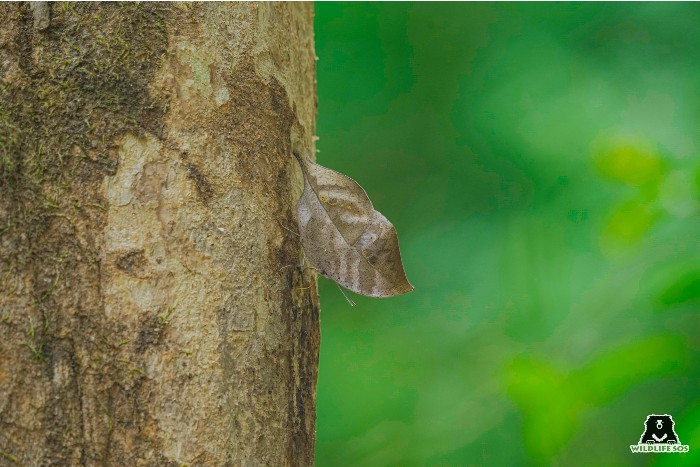Some creatures in nature seem to be experts in disguise. Have you noticed butterflies having strikingly similar patterns, or stick insects that blend in seamlessly with the branches they lie on? This exceptional phenomenon is known as mimicry, and is nature’s witty way of giving certain organisms a fighting chance at survival.
Mimicry is, in essence, the ability of one species to either closely resemble another one or an object in their surroundings. This could mean one species or the mimic looks like another species or takes on the appearance of leaves, twigs or even rocks, the model. The scientific definition of mimicry cites it as “the superficial resemblance between two or more organisms that are not closely related”. This ability is not just a quirk, it is a finely tuned adaptation that has evolved over millennia, often offering these species survival advantage in their habitats. Even though the mimic and model species aren’t closely related, the mimic gains highly from this resemblance: it can cleverly trick its predators or rivals, known as receivers, in the wild.

While mimicry aids in evading predators for several, there are those for which this improves their ability to catch prey or ward off rivals. Over time, natural selection has helped form different types of mimicry, each with their own strategy to ensure survival. In most studied cases, the advantage is usually one-sided with the mimic gaining advantage over the model.
Types of Mimicry
When categorising mimicry, it’s essential to consider the shared evolutionary mechanisms across species. Scientists often ask three main questions to declare the type of mimicry:
- Are the model’s traits being mimicked as ‘signals’ or ‘cues’?
- Does the mimic signal a benefit or a cost to influence the receiver’s behaviour?
- Is the mimic’s signal deceptive?
The first distinction splits mimicry into two main types: signal mimicry and cue mimicry. Signal mimicry is when both the mimic and the model have the same receivers — which can often be shared predators. Cue mimicry, on the other hand, occurs when the mimic and model have different receivers, or there may be no receiver to the model’s traits at all.
There are three traditional forms of mimicry: Batesian, Müllerian and aggressive mimicry. There is also a fourth category that is often overlooked called rewarding mimicry.
- Batesian Mimicry
In Batesian mimicry, a harmless or poorly defended species mimics the appearance of a more dangerous or toxic species to discourage predators. The mimic takes on the warning colours or patterns of the harmful species, relying on deception to avoid attacks. For example, many bees and wasps exhibit a black-and-yellow banding pattern as a warning to potential predators of their stingers. Hoverflies, however, lack stingers but mimic this same colour pattern to trick predators into leaving them alone, effectively using the warning signals of bees and wasps to their advantage.
The use of such conspicuous colours or patterns is known as aposematism and acts as a tool to advertise superficial defences that con predators. Aposematic markings help the mimic to mimic its model’s toxicity, venom, foul taste, sharp spines, or aggression, signalling that it’s not worth attacking.

A subcategory of Batesian mimicry, known as Wasmannian mimicry, takes deception a step further. In this form, the mimic takes on the manners and appearance of its host to live alongside it. For example, some jumping spiders mimic ants, fooling them into granting access to their colonies for food and shelter.
- Müllerian Mimicry
Müllerian mimicry is when two or more noxious or well defended species share similar physical features that warn their own predators to stay away. This form of mimicry serves as a mutual benefit to these species — their colouration or pattern are warning signals that become instantly recognisable to potential predators. When predators encounter one species and learn it is inedible or harmful, they are less likely to attack similar-looking species.

A classic example of Müllerian mimicry can be observed in the common tiger (Danaus genutia) and plain tiger (Danaus chrysippus) butterflies, which are widespread in India. Both butterflies feed on toxic milkweed plants, making them poisonous and unpalatable to most birds and predators. Their similar appearance reinforces the “do not eat” signal, as predators avoid both species after experiencing a single unpleasant encounter.
- Aggressive Mimicry
Not all mimicry is defensive. Aggressive mimicry inverts the concept followed by the previous two mimicries — it helps predators capture their prey. It is a predator or parasite tactic, where a harmful species imitates a harmless model to avoid being identified by its prey or host. The predator or parasite uses the model to exploit the recipient of the signal.

Aggressive memory, also known as Peckhamian mimicry, comes in various forms. Spider species that resemble ants allow them to remain undetected as they get within the right distance to strike them. The alligator snapping turtle and deep sea angler fish have a form of aggressive mimicry that involves the modification of certain body parts to act as lures to attract prey. This type of mimicry can also involve certain biochemical reactions that are mimicked by the predators. For example, certain predatory fireflies also mimic the lighting pattern of other firefly species to bewitch their prey.

A phenomenon called brood parasitism is also a form of aggressive mimicry where parasitic parent birds like the koel or cuckoo have evolved to mimic the colour, shape, and size of the host bird’s eggs to avoid being rejected by host species like the crow. This is a type of signal mimicry as the mimic and the model share the same receiver i.e. the host parent.
- Rewarding Mimicry
Rewarding mimicry is a fascinating form of mimicry in which the mimic signals a genuine benefit to influence the behaviour of the receiver. Unlike deceptive mimicry, where the mimic tricks the receiver, rewarding mimicry involves signals that offer it protection akin to Müllerian mimicry, along with a manipulative behaviour as seen in aggressive mimicry.
For instance, several plants with nectar rewards evolve to resemble one another, creating a shared visual or olfactory signal that attracts pollinators more effectively. This enhances the chances of pollination for all the mimicking plants.
A specific species called the carrion flower makes for a compelling example: it mimics the scent and appearance of decaying flesh. This attracts carrion-feeding insects such as flies, which mistake the flower for a site to lay their eggs. The carrion flower may also temporarily trap the insects to ensure adequate pollen is gathered by them to spread when they are released. This benefits the plants, with or without offering any direct reward to the insects.

Beyond these broad types of mimicry, nature offers a diverse array of mimicry strategies that enable organisms to thrive and evade threats in their environments. These additional types of mimicry reveal the complexity and creativity of evolutionary adaptation. Here are a few intriguing examples:
- Homotypism or Masquerade Mimicry
For some defenseless organisms, the best strategy for survival is to resemble something entirely inanimate. This is the essence of homotypic mimicry, where animals mimic objects such as leaves, thorns, or twigs to avoid detection by predators. By blending seamlessly into their surroundings, they effectively hide in plain sight.
A remarkable example of this is seen in certain katydids or bush crickets, which have evolved intricate vein patterns in their wings that closely mimic the structure of real leaves. This adaptation makes them nearly invisible to predators searching for a meal.

Another fascinating example is the caterpillar of the blue mormon butterfly (Papilio polytes). In its early stages of life, it resembles fresh bird droppings, a disguise that is highly effective in deterring predators like birds. This unappealing appearance serves as an ingenious form of camouflage, providing the caterpillar with a critical survival advantage.

- Automimicry
Automimicry refers to when an animal mimics members of its own species or have one part of its body resemble another to confuse predators. For instance, monarch caterpillars have two sets of tentacles — one at the front of its body and one at the back — making it difficult for predators to identify which end is the head.

Automimicry, also known as Browerian mimicry or intraspecific mimicry, can also involve deceptive appearances. For example, the non-venomous Brahminy blind snake is small, thin, and shiny, with a head and tail that look nearly identical. This similarity confuses predators, as they cannot determine which end of the snake is facing them, providing the snake with a valuable layer of protection.

The other form of automimicry is when individuals within the same species mimic one another, and is called Bakerian mimicry. This is commonly seen in the Caricaceae family of tropical plants, which includes the papaya. Female flowers have stigmas that do not produce pollen, but these stigmas mimic the appearance of pollen-filled anthers of male flowers. For effective pollination to take place, pollinators are tricked into visiting female flowers as much as they go to the male flowers, thereby transferring the pollen to sustain the flower species.
- Mertensian Mimicry
Mertensian mimicry, also known as Emsleyan mimicry, is a rare and intriguing type of mimicry where a highly dangerous species mimics the warning signals of a less dangerous species.
This type of mimicry flips other forms where usually, a harmful species acts as the model for the mimic. In those mimicries, predators become aware of the warning signals (bright colors or specific patterns) after their first encounter, which makes them associate those with danger. However, in the case of Mertensian mimicry, where a lethal species copies one that is less harmful, the predator does not survive to learn this association. Encountering a deadly species in disguise proves fatal for the predator in the first interaction itself, which is why such encounters persist between predator and dangerous species.

- Gilbertian Mimicry
Gilbertian mimicry is an interesting form of mimicry that involves just two species: a host or prey organism as the mimic and its parasite or predator as both the model and the target of deception i.e the receiver. In this unique interaction, the mimic adopts characteristics of its predator or parasite to manipulate their behaviour, avoiding harm and gaining an advantage.
One remarkable example occurs in the plant genus Passiflora. These plants are targeted by larvae of Heliconius butterflies, whose caterpillars feed on their leaves. To deter egg-laying by the butterflies, Passiflora plants have evolved small structures at the base of their leaves that resemble mature Heliconius eggs. Female butterflies, recognising these “egg mimics”, avoid laying their eggs on what appears to be an already-occupied plant. This strategy minimises competition and cannibalism among the caterpillars, safeguarding the plant from being overrun.

All these types of mimicry highlight the dynamic interplay between mimicry and evolution. It’s important to note that mimicry is not a rigid or static phenomenon; it represents a spectrum of adaptations that organisms use to survive in complex ecosystems. From altering body structures to mimicking behaviours, nature showcases endless ingenuity in its survival strategies.
To read more of such interesting articles on the wonders of wildlife, subscribe to our newsletter.





